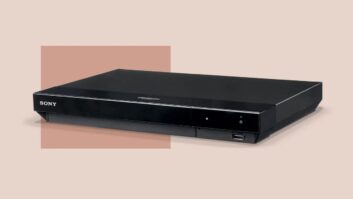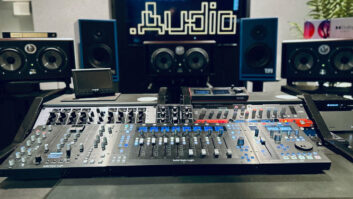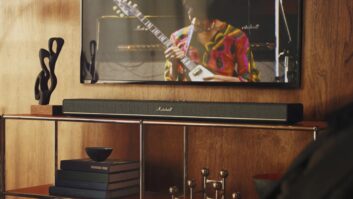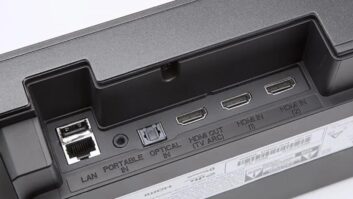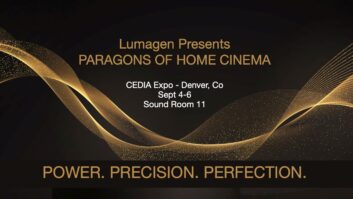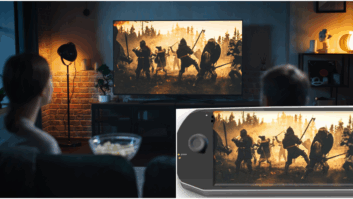Dolby Laboratories has left it up to audio suppliers to fill in a lot of blanks about the forthcoming Dolby Atmos launch in the home theater market.
Dolby provided some good high-level information about the technology’s promise on its website, but you have to go to Onkyo’s website to find out, for example, that Atmos supports 5.1.2, 5.1.4, 7.1.2, 7.1.4, and 9.1.2 speaker configurations.
As I roamed the booths at CES Week yesterday, I also learned some other key details. One is an explanation of how Atmos soundtracks will appear on Blu-ray discs without, apparently, undergoing the drawn-out process of changing the Blu-ray spec.
On its website, Dolby has promised that “existing players that fully conform to the Blu-ray specification will be able to support Dolby Atmos content on a Blu-ray disc.” Previously, Dolby told me that Blu-ray players will spit out the Atmos bitstream through their HDMI outputs to A/V receivers and preamp processors with embedded Atmos decoders.
So is there a separate Atmos soundtrack on discs, and wouldn’t that require a Blu-ray spec change?
The answer came when I watched (and listened) to a Dolby-approved Atmos demo. A menu popped up on the screen. It offered a choice: “Atmos in TrueHD” and “Atmos in Dolby Digital Plus.”
TrueHD is already approved for use on Blu-ray discs, and Dolby Digital Plus is already used for online video streaming. So it sounds like Atmos metadata, which assigns XYZ coordinates to individual sounds, will be embedded in Dolby TrueHD bitstreams much like chapter ID metadata. The Atmos metadata will place sounds in a 360-degree space with more precision than today’s channel-based surround technologies do.
The metadata and soundtrack will pass through the HDMI output of current Blu-ray players to an Atmos-equipped AVR for decoding. And for consumers who haven’t stepped up to an Atmos AVR, existing AVRs with standard TrueHD decoders will play back the TrueHD soundtrack just fine.
If that’s how the technology works, Dolby scored a coup that will put TrueHD surround technology on many more Blu-ray discs than today.
I also learned this:
–Blu-ray disc packaging will carry such designations as 5.1.4 or 7.1.4 to indicate the number of speakers that the soundtrack is optimized for.
— An Atmos AVR will improve the sound quality of non-Atmos discs because of the AVR’s higher processing power, which is required to interpret Atmos metadata. I don’t know yet whether an Atmos AVR will generate some degree of more localized placement of sounds from a standard soundtrack.
–Dialog will be intelligible at home at listening levels lower than what you’d normally hear during a retail demonstration.
–Atmos-optimized speakers with an angled top-firing driver are optimized for rooms with 8- to 14-foot ceilings. The drivers reflect sound off the ceiling to deliver overhead sound effects.
–And, to optimize overhead sound effects, consumers who go the in-ceiling speaker route will have to place two to four in-ceiling speakers about a quarter way from the side walls.
Many of these details will likely be addressed by Dolby on August 15, when the company is said to be planning a follow-up announcement as we all prepare for the CEDIA Expo. Most likely, the announcements will also include details on the release of Atmos-encoded Blu-ray discs and movie streams and perhaps on Dolby’s own promotional plans.
So far, Dolby has said only that Atmos surround sound will begin appearing on Blu-ray discs and streaming services this fall, with more titles to come in 2015.
Dolby itself is saying only so much, but we wouldn’t have heard anything at all unless audio suppliers pushed Dolby to let them release their Atmos product plans this week. Suppliers wanted to get the word out so they could generate retail excitement and give retailers time to set up demonstrations in time for the fourth-quarter selling seasons.
Demos will be instrumental in promoting Dolby Atmos, which could lift component-audio sales because of the striking improvement it brings to home theater audio. It gives consumers a clearly audible reason to replace their existing AVRs and speakers, and it does so without requiring the installation of on-wall height speakers that clutter up walls.
At the very least, Atmos will encourage sales of new AVRs and Atmos-enabled speaker modules, which could be placed on top of existing speakers to deliver overhead effects.
Atmos offers a more compelling reason to replace existing audio components than just about anything else that has come along in years.
Installers and A/V specialists, rejoice!




